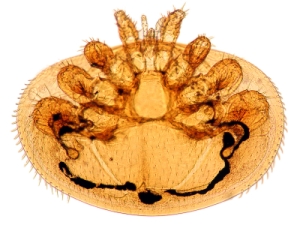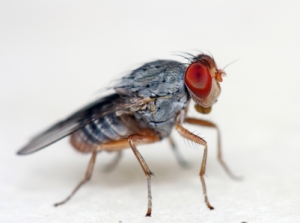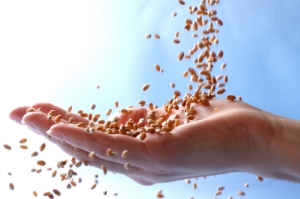A worm bin is a complex ecosystem with many micro organisms that help to break down decaying matter. In fact, without a healthy assortment of worm bin critters your worm composting system would not be functional. The majority of these critters will stay in the bin where conditions are most favorable to them. The fruit fly is an exception to this rule. But even fruit flies can be managed. We’ll discuss some management techniques later in this post.
First lets get acquainted.
Mites

Mite

Spider Mite
Mites are related to spiders and have 8 legs. They range in color from browns, reds, yellows and whites. Mites are very beneficial to your worm bin and are often the first critters to start breaking down the food.
Springtails

Springtails
Springtails are usually white but can be gray or brownish in color. They move about by crawling or jumping. To jump they use their tails which are normally curled in close to their tummies. As they push forward from the tail they spring up. They do not have wings and will not stray out of your bin. You’ve probably noticed springtails on soil surfaces around your potted house plants. They appear when conditions are moist and when there is decaying material to consume. But don’t worry. They won’t eat live plant matter and are therefore completely harmless. They’re also so tiny that you’ll hardly even notice that they’re there.
Sow Bugs or Pill Bugs
 This photo approximates the actual size of sow bugs or pill bugs (also called the woodlouse). Sow bugs are occasionally introduced to indoor worm bins on egg ridden leaves which are brought in from outdoors. They are quite beneficial to the worm bin, however, due to their size, they’re generally not appreciated. To avoid sow bugs in indoor bins, we recommend that you don’t add leaves and other debris from outdoors.
This photo approximates the actual size of sow bugs or pill bugs (also called the woodlouse). Sow bugs are occasionally introduced to indoor worm bins on egg ridden leaves which are brought in from outdoors. They are quite beneficial to the worm bin, however, due to their size, they’re generally not appreciated. To avoid sow bugs in indoor bins, we recommend that you don’t add leaves and other debris from outdoors.
Centipedes

Centipede
Centipedes, like sow bugs, are usually introduced to indoor worm bins through the addition of outdoor leaves. They are very rare in indoor worm bins, but they do occasionally appear. If you see one or two centipedes you should carefully remove them. These guys do eat worms. They occasionally bite people too, though they’re not generally poisonous to humans. It’s best to be cautious when removing them. To avoid introducing centipedes, avoid adding leaf litter to indoor bins.
NOTE: Leaf litter is, however, a great addition to outdoor worm bins and/or composters. Red Wiggler worms are especially fond of leaves and by adding leaf litter to the surface of your yard and garden, you can attract large numbers of earthworms to these areas.
Fruit Flies

Fruit Fly
The fruit fly is the certifiable pest of all compost systems. Fruit fly eggs are present on virtually all fruit skins before you even bring your produce home. They will hatch in your fruit bowl, in your counter top compost bucket and, yes, they will hatch in your worm bin too. The best way to avoid fruit flies is to wash, cook, or blend the compost before it is added. Some sources suggest freezing to control fruit flies but that does not work. The fruit flies will simply hatch as you thaw out your produce. If you’re not inclined to cook, blend or wash everything that goes into the bin, you may also bury the food scraps deep enough that the hatching fruit flies can’t escape. A nice thick layer (3 inches or so) of shredded paper over the surface of the worm bedding will help. As will the addition of some old carpet or burlap.
For the few vagrants that do escape you may wish to have a fruit fly trap strategically placed either inside or next to your bin. There are a variety of fruit fly traps on the market, like the reusable phony apple version called the Trapple. Or you can easily make your own.
To make your own fruit fly trap, place some attractant liquid (we suggest pineapple juice) in a bottle with one drop of liquid detergent (to disrupt the liquid surface layer). Then place a funnel with a tiny hole through the bottle opening. The tiny hole will enable the flies to enter but the funnel will make it impossible for them to leave. A quick and easy funnel can be made by cutting the corner out of a ziplock bag and stuffing that corner into the bottle opening. Voila!
If you have any questions or experiences to share regarding critters in your bin, please feel free to post them here.
copyright 2009 Jennifer Englert. All rights reserved.
Read Full Post »
 Seedy Saturday is a National program that’s organized every spring by Seeds of Diversity. The goal is to encourage the exchange of heritage seeds and to share information relating to organic agriculture. To find dates and event details for your area, click
Seedy Saturday is a National program that’s organized every spring by Seeds of Diversity. The goal is to encourage the exchange of heritage seeds and to share information relating to organic agriculture. To find dates and event details for your area, click



 This photo approximates the actual size of sow bugs or pill bugs (also called the woodlouse). Sow bugs are occasionally introduced to indoor worm bins on egg ridden leaves which are brought in from outdoors. They are quite beneficial to the worm bin, however, due to their size, they’re generally not appreciated. To avoid sow bugs in indoor bins, we recommend that you don’t add leaves and other debris from outdoors.
This photo approximates the actual size of sow bugs or pill bugs (also called the woodlouse). Sow bugs are occasionally introduced to indoor worm bins on egg ridden leaves which are brought in from outdoors. They are quite beneficial to the worm bin, however, due to their size, they’re generally not appreciated. To avoid sow bugs in indoor bins, we recommend that you don’t add leaves and other debris from outdoors.
